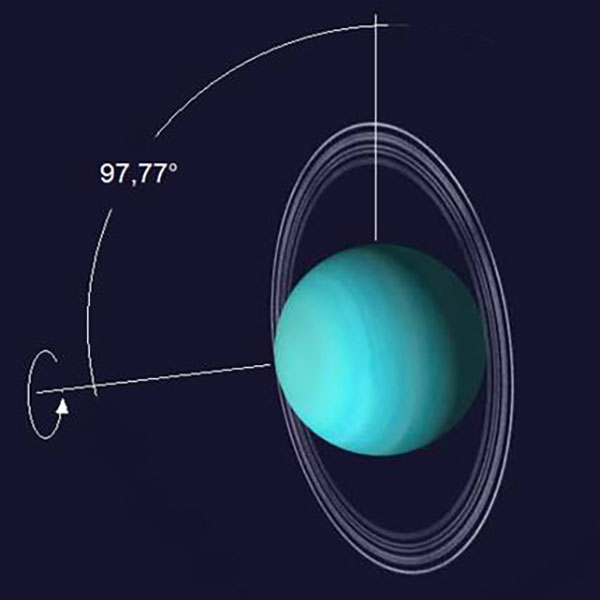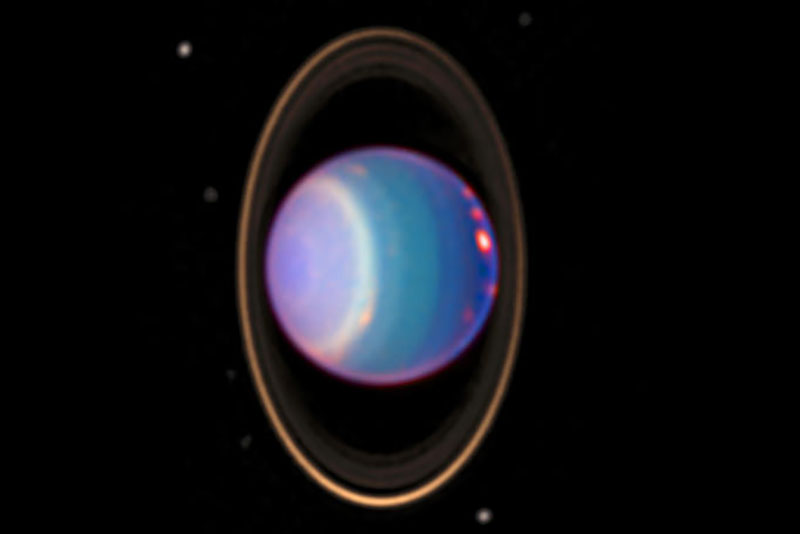Sir William Herschel discovered Uranus in 1781. Gaseous planet and seventh in distance from the Sun (about 2,800 million km from our star), its diameter is four times that of Earth and it rotates on its axis in 17 hours. The temperature at the top of its clouds reaches -210° C.
It is a gaseous planet with a metallic and rocky core, covered by a sea of liquid hydrogen and a deep atmosphere. Uranus has no striking visual features, no clouds are seen, just a uniform blue-green ball. Like Saturn, Uranus has rings, separated by large divisions. It is estimated that they could have formed after the planet received a strong impact during the formation of the Solar System.
Uranus, the planet "wheel"
This planet is the only one whose axis of rotation is very close to its plane of orbit, inclined at almost 98°. Since it orbits the Sun in 84 Earth years, during the summer of the south pole in the northern hemisphere there is a continuous night of 42 Earth years (while the opposite hemisphere receives sunlight for 42 years, and then the situation is reversed).
An important fact is that astronomers had discovered obvious anomalies in its orbit, which led to the assumption that a body was exerting some type of gravitational force on it. This is how years later the existence of the eighth planet, Neptune, was announced.

Current data on Uranus is more complete due to the passage of the Voyager probes, which revealed the presence of dark rings, not as spectacular as those of Saturn; Its size is similar to that of its neighbor Neptune, as is its chemical composition; Its magnetic field keeps it protected from the solar wind.
Its only visitor has been the Voyager 2 probe, in 1986, which managed to get within 82,000 km of the planet, obtaining information about the upper layers of the atmosphere and many other details.
He discovered 10 other satellites of the planet and details regarding its exaggerated axial inclination. Likewise, its ring system was investigated, and it was found that they are different from those of Jupiter and Saturn and perhaps much more recent.

Regarding its satellites, interesting topographic features were discovered in Miranda, as well as the verification that its main moons are basically composed of rock and ice.
A magnetic field was discovered on Uranus, of similar intensity to that of Earth, with an inclination of 60º independent of the axis of rotation, implying that this field is "dragged" by the planetary rotation.
| CHARACTERISTICS | |
| Diameter | 51,118 km |
| Mass | 8,686 x 1025kg |
| Density | 1.29g/cm3 |
| Gravity | 8.69 m/s2 |
| Surface temperature | -205 ºC (med) / -214 ºC (min) |
| Axial inclination | 97.86° |
| Escape velocity | 21.29 km/s |
| Rotation | 5:14 p.m. (retrograde) |
| Translation | 84 at 3 a.m. 3 p.m. |
| Orbital speed | 6.84 km/s |
| Eccentricity | 0,04716771 |
| Albedo | 0,51 |
| Distance to the Sun (average) | 2,870,972,200 (19.19 AU) |
| Number of satellites | 27 (known) |

